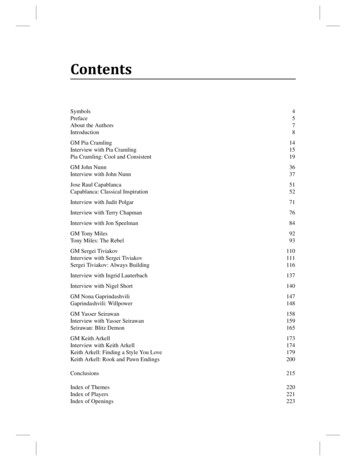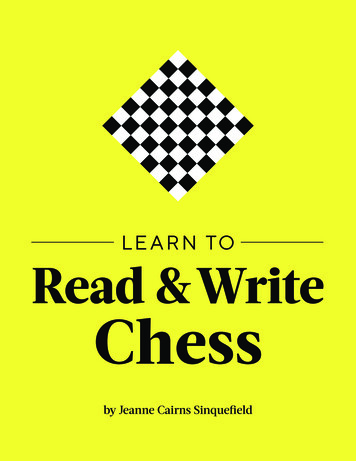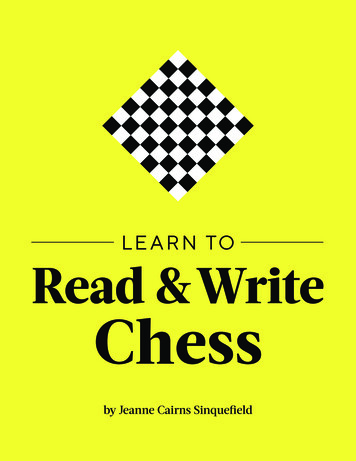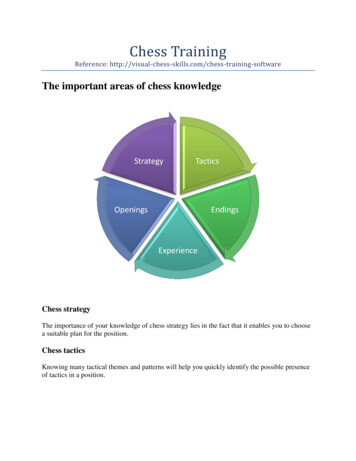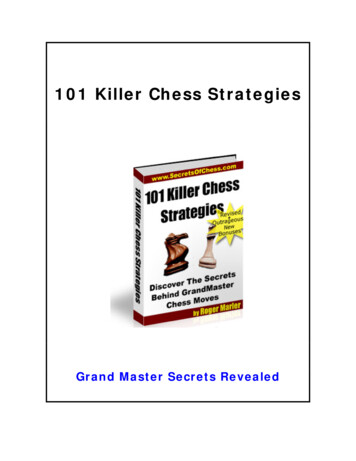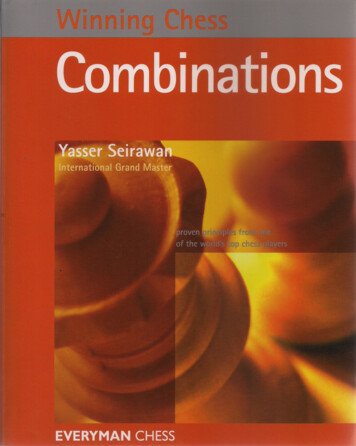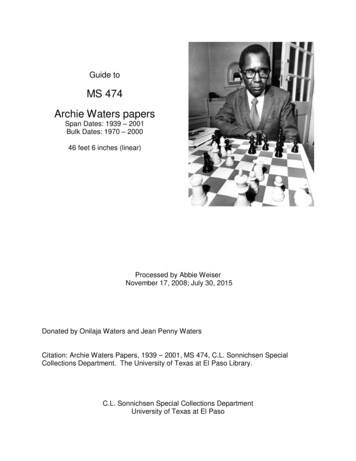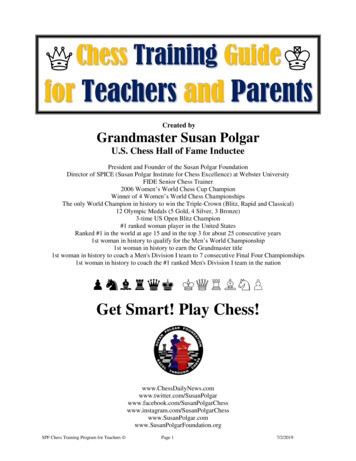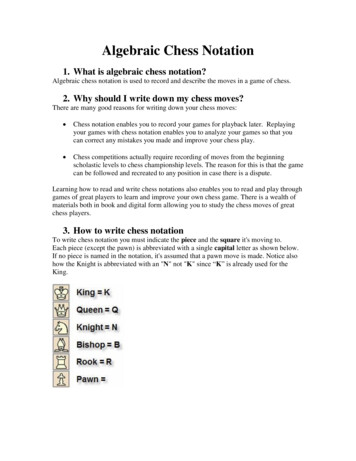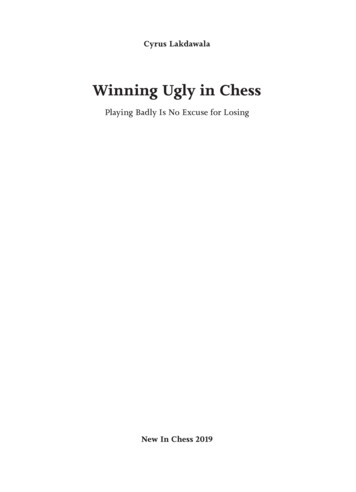
Transcription
Cyrus LakdawalaWinning Ugly in ChessPlaying Badly Is No Excuse for LosingNew In Chess 2019
ContentsExplanation of symbols . . . . . . . . . . . . . . . . . . . . . . . . . . . . . . . . . . . . . . . . . . . . . 6Introduction . . . . . . . . . . . . . . . . . . . . . . . . . . . . . . . . . . . . . . . . . . . . . . . . . . . . . . . 7Chapter 1Missed appointments:how can we escape the Law’s reach? . . . . . . . . . . . . . . . . . . . 13Chapter 2I’m not a therapist, so I can’t comment: how to flusteryour opponent with an opening surprise . . . . . . . . . . . . . . 83Chapter 3Vertigo: how do we grasp the ungraspable? . . . . . . . . . . . . 124Chapter 4How to squeeze something from nothing . . . . . . . . . . . . . 187Chapter 5Rise of the Machines . . . . . . . . . . . . . . . . . . . . . . . . . . . . . . . 227Chapter 6When bunnies attack . . . . . . . . . . . . . . . . . . . . . . . . . . . . . . . 250Chapter 7Combustion: why do we play so inspirationally againstcertain opponents? . . . . . . . . . . . . . . . . . . . . . . . . . . . . . . . . . 260Chapter 8Epics . . . . . . . . . . . . . . . . . . . . . . . . . . . . . . . . . . . . . . . . . . . . . . 286Chapter 9The lunge: when should we go for it and when shouldwe hold back? . . . . . . . . . . . . . . . . . . . . . . . . . . . . . . . . . . . . . . 309Chapter 10The King . . . . . . . . . . . . . . . . . . . . . . . . . . . . . . . . . . . . . . . . . . 323Index of players . . . . . . . . . . . . . . . . . . . . . . . . . . . . . . . . . . . . . . . . . . . . . . . . . . 334Index of openings . . . . . . . . . . . . . . . . . . . . . . . . . . . . . . . . . . . . . . . . . . . . . . . . 3365
Introduction‘Nothing endures but change’ – HeraclitusFinding equanimityDo we not all strive for the unattainable, the way a homely little girl playswith the Barbie doll who she will never look like? In our chess games mostof us seek a kind of secular divinity by playing what we consider a perfectgame. But how often do we actually get these kinds of games? Maybe10 games in our lifetime if we are lucky? In reality we all reach for theparadise which is nearly always lost. Most of our wins are far from straightline trajectories and instead are filled with bumps and misadventures.Chess is not like other endeavors. We never hear a bus driver say outloud: ‘I have never driven the bus as well as I did today,’ or, ‘Man, I’mdriving terribly this week. I wonder if I’m in a driving slump?’ My jobas a teacher, much like a psychologist, often entails that I simply listensympathetically while the student recounts the terrible tragedy whichoccurred in his or her game.In our games, when does the line between smooth and bumpy begin toblur? In my own games, the smooth Capablanca-like performances I seekhave a disconcerting way of morphing into a disjointed conglomerationof misfit pieces and plans, both from my opponent’s side and from myown. When our side plays better than the other and loses anyway, we mayfeel cheated and somehow robbed of our just reward since the universeisn’t functioning as it should. The purpose of this book is that we learnto actually expect our games to go this way, rather than live in the falseexpectation of the perfect, error-free masterpiece. In essence, most ofus psychologically exist expecting an ostentatious display of our wealth,while in reality we are living a life of abject poverty.This is neither a time for creative gluttony, nor asceticism, but instead,a time for balance, accepting good and bad moves in our games withequanimity. Chess is too complex for most human minds and we mustfactor in errors and then find a way to win anyway. In some of the gamesI selected, the connection to reality seems to be merely incidental. Theone thing they have in common is their lack of smoothness. The gamesselection was difficult, since I looked for ones which were obscured in acataract of grays, rather than the straight line linear trajectories where,let’s say White achieves a ‘䩲’, adds pressure and reaches ‘ ’ over ‘-’, and7
Winning Ugly in Chessthen on to a ‘ -’ winning position, and finally the winning side looksupon his position with a benevolent smile and an approving gaze, as theposition begins to sprout answers. Then the winning side finds the clevercombination to put his or her opponent out of his or her misery.Instead, we examine games which don’t invite emulation! Chess is theonly activity I know where fear and exhilaration mingle equally. Entry intosuch a variation means that we agree to be tossed about by unthinking/unfeeling chance. Real life is not the movies where in the end the heroor heroine’s wishes are fulfilled. Tournament chess is a struggle of ups,downs and gray neutrals. One key motif in this book is to learn what weshould do when matters don’t go our way. We learn how to be the mastersafecracker who knows just how to charm and sweet-talk the combinationfrom the tumbler lock. Mean Caissa isn’t one of those deities who pourbenevolent bounty from their cornucopia to anyone – just to her favorites,her Morphys, Capablancas and Fischers. For the rest of us it’s just crumbs.And so our games are full of bumps of good fortune/misfortune. This booktries to teach us how to win when life isn’t in a bull market. Essentially,Capablanca is banned here. Every reader of this book deserves praise sincemost of our lives we have been tested harshly by chess, yet we remainfaithful players, refusing to switch to monopoly or tic tac toe.What is there to learn in this book?When I began this book, I didn’t intend it to be one full of contradictory/anomalous games, which merely amuse the reader, yet don’t teachanything. I did my best to instruct as well, not just in chess, but inthe mind states we need during a chess game. Throughout the book Iinserted a term which New in Chess publisher Allard called ‘Momentsof Contemplation’, where the reader isn’t asked to solve a puzzle or finda plan (it’s not a puzzle to be solved if there is no concrete solution),but instead, look for a way to trick the opponent, or find the bestpractical chance in an otherwise grim situation. With these moments ofcontemplation we go to a place where there are no clear demarcation linesof right and wrong. We simply look for a move or idea which maximizesour chance for survival or maybe even victory via a swindle.This won’t be one of those ‘greatest hits’ books where you recognize90% of the games, since I searched for confrontational and also whimsicalplayers. I also used games from players who are friends whose styles Iunderstand, like IM’s Jack Peters, Dionisio Aldama and Keaton Kiewra,since their troublemaking styles are perfect models for this book.A position’s reality is often way past our perception, and, on rareoccasions, way past what we can even imagine. This book is designed to8
Introductionbe a user’s guide on how to deal with change in our chess games. In mostchess books we are used to seeing superbly played games with very fewerrors on both sides. Well, such games are actually anomalies. In reallife club-level chess, most of our games are poxed with dubious marks,question marks and double question marks.Here is what you can learn from this book:1. How to deal with jarring rhythms and retain a mind state ofequanimity, when the chessboard in front of you is on fire. Psychologiststell us that once we know the outcome of an event, we tend to falsely believethat it was more predictable than it actually was, which is a fancy wayof saying: hindsight is always 20/20. This book is a simple reminder of adifficult-to-accept fact: our chess, much like our actual life, doesn’t always gothe way we expect it to turn out. We want our games to move in a straight,upward trajectory to our goal and what we usually get instead is the baroque,the convoluted, and, worst of all, the unexpectedly unpleasant. Normallywe like to draw a moral from chess games. For example: Black neglecteddevelopment in the opening and was quickly punished with a mating attackfrom his opponent, who developed rapidly and then opened lines, followingall the principles. In this book this scenario is often reversed, and we are leftwith an uncomfortable feeling that the wrong player won the game. Whengoing through a smooth Capablanca game, we get this odd feeling that astring quartet plays softly in the background. I assure you that you won’t getthat feeling from going over the games in this book!2. Learn how to flip flop a result – the more undeserving, the better.3. How to avoid self-inflicted wounds and discover why it is so mucheasier to poison our own position, than to cure it.4. Avoid paranoia. The paranoid’s creed goes: if you regard everyonewith suspicious distrust, then you can never be betrayed. I also looked forgames which involved losses through paranoia.5. The art of provoking your opponent: if you wish to provoke theopponent into a rash action, then un-guard something to tempt him or her.6. Learning the difference between genuine versus faked audacity, andhow to make certain you don’t fall into the latter category.7. Learn how to grab material and get away with the crime: the proceedsearned from theft must be balanced with the level of risk involved. In thisbook we examine the fine lines between greed and generosity.8. Panicked versus Irrational Decisions: one is certain to fail, while theother may succeed.9. In this book we learn that an astonishing chess game cannotarise from one side alone. Instead, it’s a collaboration which requires aconspiracy from both players to give it birth.9
Winning Ugly in Chess10. We learn the moment for both action and inaction. The line can beincredibly thin.11. Learn how to set up reverse traps: there are traps and there arereverse traps, where the prey is the trapper himself. It’s a disconcertingrevelation when we realize that we aren’t quite as clever as we thought.12. Learn how to create reverse miracles: the book is loaded withperverse reverse miracles, where the wrong player (from the standpoint oflogic) wins games, where one side leads a charmed existence, breaking allthe rules, and gets away with it. In case you were wondering, that would beour side. When Mother Caissa grants you a miracle, my advice is that youdon’t throw it back in her face. The trouble is most of us fail to sense themiracle when it is about to happen. In this book we try and get a feel forthat perfect moment when we sense opportunity.13. How to deal with the swamp, which is the serial killer’s dumpingground of submerged corpses. We look at how to navigate irrational games,which fit outside any strategic reference point and where the only rule isthat there are no rules.14. The lunge: when to go for it and when to hold back?15. This is the most important one of the entire book: become a masterof the Moment of Contemplation, where if no solution exists over theboard, we look for a psychological ‘solution’. Remember this: the only wayto shake an otherwise solid opponent is to unfollow the normal playbook.We see, over and over in this book, cases where ingenuity, born ofdesperation, overrides the opponent’s logic. We are not a Hobbit in MiddleEarth, on some noble quest. When in trouble, our goal is resistance, and ifthis resistance includes embracing the irrational, then we embrace it.Here is a glimpse at some of the positions we encounter in the book:TsLdM .t. Sl. JJ .j. JiiIjI Ij. . . . . . .i. . .rNbQkBnRIn this game, White, Emil Diemer of Blackmar-Diemer Gambit fame,played the opening like a toddler who understands how pawns move, buthas yet to grasp how pieces move. He made 17 consecutive pawn moves10
Introductionand was rewarded with a busted, overextended position. Somehow hemanaged to survive and win later on with a series of impossibly brilliantsacrifices.TsLdMlStjJjJj.jJ. . .j. . . . . I . . . .IiIi.iIirNbQkBnRThere are bizarre first move choices, and then there are those fromanother dimension. This is Morphy-Barnes, first match game. Barnes, in afeat of breath-taking audacity, taunted Morphy with 1.f7-f6?, which someof us would interpret as an assault on decency itself. We all know thatBarnes will lose this game with the sureness of prophecy and one of theplayers did indeed lose without putting up much of a fight. Guess who wonthe game?. . . . T . J.j. .qJm.j. J .J B J .i. .s. I.iI . IK . R .When we were kids we could always sense the boogieman nearby atnight, yet we never ever caught a glimpse of him. As Black and withWhite to play, GM Larry Christiansen found himself down a full queenagainst a master. His position was fresh out of miracles, so he decidedto construct one of his own by winning this game. How? On time? By acolossal swindle? No. He simply took advantage of his opponent’s missedopportunities and slowly outplayed White from this position. It turnedout to be one of those movies where the dead refuse to remain dead. Weall sing our hymns of suffering and loss to any chess friend who is willingto listen. I sense the torment of Christiansen’s opponent explaining to afriend how he was up a full queen against a GM, yet lost.11
Winning Ugly in ChessT . . MjJ . . J. .j. J. .l.i. . .s.n.i.kI .IiB . Dr.bQ . .You know those pharmaceutical ads which list their drugs’ side effects: lossof appetite, night sweats, dizziness, nausea, mood swings, depression andthoughts of suicide? Well, I suffered all of those and I didn’t even take thedrug. The problem was, as White, I looked up and saw my IM opponent’shomicidal eyes boring through my unfortunate king. Somehow I managedto fluke my way out of trouble, despite the awful current assessment. . . T. . . .J . . .sJ M J I.i.iJi.i. .iR. . Q .D .bK .In the above position Larsen was up two full pawns against Bronstein.The pawns didn’t do him a bit of good since Bronstein engineered anunbreakable light-square blockade. Larsen played the mother of alllunges, g3-g4!?!?, followed by the sacrifice of two more pawns to go afterBronstein’s king. No, this isn’t a sign of impaired cognitive function onLarsen’s part. Before you accuse Larsen of overpromising and underdelivering, consider this: it managed to fluster the great David Bronstein,who went on to lose an unloseable game.When our victorious opponents utter those awful words: ‘You playedwell’, they tend to fall flat to our collectively empty ears and hearts. Andthen later we are dizzy with elation when we defeat this same opponent ina close/exciting game. It’s foolish to get depressed when the sun sets andjust as foolish to be elated when it rises the next morning. So next timewe win or lose a close game, may we learn the lesson to ride the happy andcruel tides of fortune with equanimity.12
CHAPTER 2I’m not a therapist, so I can’t comment:how to fluster your opponent with anopening surpriseIn this chapter we look at the eccentric and the just plain weird, when itcomes to opening choices. The lesson from this chapter is that openingambushes do sometimes have a debilitating psychological effect on ouropponent’s following move choices.83
Winning Ugly in ChessGame 17Barnes DefencePaul MorphyThomas BarnesLondon m 18581.e4This game is clear proof thatMorphy was a liar, since we seethat an overwhelming developmentlead, central control and aweakened opposing king meansnothing! This game’s obnoxiousepilogue is that sometimes the sidewho plays by the rules is the onewho loses.Moment of Contemplation:1.f6?TsLdMlStjJjJj.jJ. . .j. . . . . I . . . .IiIi.iIirNbQkBnRGames like this one are why mybooks are so admired for theiracademic excellence. Really? 1.f7-f6? against Paul Morphy? Well,best of luck to you!My ChessBase program got soflustered by Black’s first move,that it incorrectly categorized itas a ‘Queen’s Fianchetto Defence/Nimzowitsch Defence’. This absurdmove is more an open insult thana chess opening, and is made withthe thought: it’s dangerous for an84exceptionally intelligent child toshow his average peers the trueextent of his intelligence, sinceit tends to get him beaten up. Wehave always been taught that thewages of sin is death. However,after we see what Barnes got awaywith in this game, we may want toreconsider.Black’s ‘opening’ comes from norecognizable species, although Iwas stunned to see 155 possiblymentally unbalanced players openwith it in my database, with Blackscoring an astoundingly high30%. A move like 1.f7-f6? appliesimmediate psychological pressureon White, since any result otherthan a win will be humiliating.We chess players endlessly debatethe merits or demerits of openinglines like religious controversiesfrom opposing doctrinal camps.Not here, since pretty much everychess player in the world (exceptthe 155 in the database) wouldagree that Black’s first move isidiotic. It looks like a half-heartede-pawn version of a Dutch Defenceprototype, which only went halfwayto the f5-square. But I’m afraid youropinion of Paul Morphy will benotched down a tad after viewingthis game, since he got flustered andstrategically crushed by 1.f7-f6!.What I loathe so much about ourcurrent chess era is the heavymemorization required (especiallyfor those unfortunates out therewith acorn-sized brains, likeyour writer), just to avoid getting
Chapter 2– How to fluster your opponent with an opening surprisebeaten in the opening. So we havebecome a community of Druids,celebrating the Winter Solstice,and our openings have become25-move rituals, to be memorizedunthinkingly.2.d4Do you remember the Star Trekepisode where Spock’s bloodboiled during the Pon farr matingritual? According to my databasethe lifetime score between Barnesand Morphy was 6-3, with onedraw, in Morphy’s favour. I imaginethat Morphy’s blood boiled thesame way at this point and that heanticipated clobbering Barnes injust a few moves.2.e6Going into gambit mode with 2.e5 is also not so wonderful forBlack after 3.dxe5 c6 4. f3 fxe55. c4 f6 6. g5 d5 (pretty muchforced. For Black it almost lookslike an awful version of the FriedLiver Attack where Black, notWhite, parts with material) 7.exd5 a5 8. d3 xd5 9.0-0 with astrategically wretched position forBlack, Glembek-Barbalic, cr 2009.3. d3 e7From the five games from thisposition in my database, onlyMorphy was the one to lose. It’s amercy that he isn’t alive to knowthis fact, otherwise his blood wouldhave boiled even more.4. e3It looks too early to commit thebishop to e3. 4. f3 is more flexible.4.d5 5. c3 dxe4This move turns the game into asort of crappy Rubinstein Frenchfor Black, with his e7-knightmisplaced and the idiotic .f7-f6tossed in.6. xe46. xe4 is also good for White.6. d5 7. h3?!He should have preserved hisbishop with 7. d2.7. e7 8. h5 !?‘Patzer sees a check, patzerplays a check’ doesn’t apply toMorphy, who, much like the OldTestament God, hankers to dole outdisproportionate punishment to thesinner sitting across from him. Thismove actually reduces White’s edgesince Black actually benefits from.g7-g6. 8. f4! looks superior.8.g6 9. h6TsLdMl.tjJjJs.jJ. . Jj. . . . .iI . B . .IiI .iIirNbQk.nRTsLdM .tjJj.l. J. . JjJq. S . . .iN . Bb. NIiI .iIir. .k. R85
Winning Ugly in Chess9. f8!First Barnes opens with 1.f7-f6 andthen he un-develops his bishop.This is actually a good move sinceit prevents White’s queen frominfiltrating g7 and, secondly, itprepares a fianchetto (an oddconcept in 1858) which strengthensthe black king’s defensive barrier.10. h4 g7 11.0-0More accurate was 11. h6 0-0 12.c3.11.0-011. b4?! wouldn’t bother White,who could play 12. c4! and dareBlack to fall even further behindin development if he grabs thec2-pawn.12.c4?This move allows Black to force afavourable ending. White retainshis edge after 12. h6! b4 13. c4! xc2 (13. xd4? hangs a pieceto the simple 14.c3! when Black’squeen is unable to touch White’sc4-bishop) 14. ad1 xd4 15. e3 bc6 16. xd4 xd4 17. c5 f518. g5 h6 19. cxe6 xe6 20. xe6 h8 21. f7 xf7 22. xd8 xd823. xf7. Black’s one pawn fails toprovide full compensation for theexchange.TsLd.tMjJj. .lJ. . JjJ. S . . IiN .q. Bb. NIi. .iIir. . Rk.8612. xe3! 13.fxe3 f5!TsLd.tMjJj. .lJ. . J J. . J . IiN .q. Bi. NIi. . Iir. . Rk.Advantage Black! Now we see thecoiled spring effect.It’s a shock when your opponentimagines that you are weak andthen he or she discovers youare not. When a great attacker/tactician meets a great strategist,each is skilled in the area the otherisn’t. Morphy had a tough timestylistically against Barnes, whowas kind of a Petrosian prototype.Barnes was actually a remarkableplayer for his time, since heplayed in as un-romantic a styleas possible, in the heart of theRomantic era. His ultra-defensivestyle is best described as roachesscurrying for dark corners, whenthe kitchen lights are turned on.14. eg5 h6 15. f3Morphy resigns himself to aninferior ending. 15. f3? is unsoundafter 15.c5! 16. g3 cxd4 17.e4 d718.exf5 exf5 19. e1 e8. There isno good way for White to press hisattack: 20. xe8 xe8 21. f3 c5and White has lost the initiative,remains down a pawn and hiswould-be attack is a fiction.15.e5?!
Chapter 2– How to fluster your opponent with an opening surpriseBlack should have jumped on thequeen swap immediately with15. xh4! 16. xh4 g5! 17. g6 e818. f2 h7 19. e5 xe5 20.dxe5 c6. Black will be up a pawn withthe superior structure.16. xd8 xd8TsLt. MjJj. .l. . . Jj. .jJ . Ii. . BiN NIi. . Iir. . Rk.Exercise – Moment ofContemplation: Black threatensboth 17.e4, winning a piece,and also 17.exd4. Should Whitecomplicate with 17.e4, or should heoffer a pawn with 17. c2, bankingon his development lead in theending?17. c2?When we look at these ancientgames, we come to a realizationthat the players of the era didn’thave the foggiest notion of whatthey were doing, strategically. Inthe context of present-day strategicknowledge, even giants like PaulMorphy sometimes played withabysmal lack of understanding, bytoday’s standards. His sacrifice ismade with the thought: power isseized by force, not inherited viainaction. Morphy reasons that inthe midst of a strategic emergency,the time to act is now, and notat our earliest convenience. Hesacrifices a pawn for a developmentlead, which isn’t nearly enough withqueens off the board.Answer: White would still be in thegame if he found 17.e4! f4 18.d5 whenBlack only stands a touch better.17.exd4 18.exd4 xd4 !Barnes calls Morphy’s bluff. Whitedoesn’t get enough for the pawn.19. xd4 xd4 20. fe1?!White puts up a better fight with20. f4! f7 21. ae1 a6 22.h4.20. f7 21.c5?!Even a genius can have an off-day.The pawn push weakens White’sc-pawn, while enhancing the powerof Black’s bishop. He should haveplayed 21. ad1.21. e6 22. ad1Ts. . .jJj. M . . L Jj.i. J . .t. . . . NIiB . Ii. Rr.k.White’s development lead ismeaningless, since he lacks routesof entry into Black’s position.22. c6 23. xd4 xd4 24. a4!?Morphy offers his a2-pawn indesperation, rather than play24. b1 g5! when White is losingwithout much of a fight.24.g5A sensible move, hemming inWhite’s knight, while pushing87
Winning Ugly in Chessforward his kingside pawn majority.Black could get away with thegreedy 24. xa2! 25. d1 e6 26.c6bxc6 27. xc6 b8 when White’srook entry to the seventh rank ismeaningless.25. d1 d8 26.a3 f4 27. f2 e2 !Principle: Swap pieces when ahead inmaterial.28. f1 xd1 29. xd1 d4 30. e1 f6. . . .jJj. . . . Lm.j.i. .j. .s.j.i. . . .i. .nIi. Bk. .White’s passive and pawn-downposition is manned by a crew ofpale, haggard ghosts, more thanable-bodied pieces:1. Black is up a healthy pawn;2. Black’s minor pieces are moreactive;3. Black has a dominant kingposition.The position is a rather easytechnical win for Black, which heconverts rather easily against a nowdispirited Morphy, whose blood hasstopped boiling.31. d2 b3 !Now we can add a superior minorpiece to Black’s growing list ofadvantages.32. xb3 xb3 33. g4 g6 34.g3h5 35. f288If 35. e5 f5 36.gxf4 xf437. g6 g4 38. c3 a2! 39. d4 h3 Black wins a second pawn.35. f5 36. c3 d5 37. d4. . . .jJj. . . . . .iL MjJ. .k.j.i. . .i.i. .n.i. . . .Exercise (planning): What isBlack’s clearest conversion plan?37.c6He doesn’t need this move.Answer: Black wins faster with37.fxg3 38.hxg3 g2! with .h5-h4to follow, winning White’s knightsoon.38.b4 g2 39.gxf4 xf4. . . .jJ . . . J . .i. .jJ.i.k.m.i. . . . . .nLi. . . .It becomes clear that Black willcreate a passed pawn on the kingside which will win White’s knight.40.a4 f1He wants to prevent d3 annoyances. 40.h4! 41. d3 g442. f2 f3 43. e4 f4 44. f2 g4simply gains a tempo for Black.
Chapter 2– How to fluster your opponent with an opening surprise41. e4 h4 42. d2 e2 43. e4 g4Black’s moves are not exactlydifficult to find.44. f2 f3 45. e4 f1Quicker was 45. g2! 46. e3 xh2! 47. xe2 g3 48. g5 g249. f3 g3. White is helplessagainst the push of Black’s h-pawn.46. e5 d3 47. g5 g2 48. d6 xh2 49. c7 g3 50. xb7 h3 0-1. . . .jK . . . J . .i. .n.Ii. . J. L .mJ. . . . . . .Black is just a wee bit faster inthe promotion race. Now weget a picture of the humiliationlevel Robert E. Lee felt when hesurrendered his sword to UlyssesS. Grant. This must have beenthe most vexing loss of Morphy’slife, since his weaker opponentattempted to mess with his headwith the insult 1.f6?, and the sadpart of it is, it worked.Game 18Sokolsky OpeningRobert James FischerJ. GlogerCleveland simul 1964If a single word was all I wasallowed to describe the lifeof Bobby Fischer, it would be:‘loneliness’. When we look back,it’s difficult to gauge if humanityprospered or was made worse by hisexistence. I, for one, place aside hisdisturbed behavior and focus on hisart, since he redefined the meaningof just what the human mind iscapable of on the chess board.The collective memory of our paststudy has made us the playerswe are today. I worshipped bothCapablanca’s and Fischer’s chessgames as a kid (and still do!) andI think their styles led me to lookfor clarity and harmony in my ownchess.1.b4!?TsLdMlStjJjJjJjJ. . . . . . .i. . . . . .I IiIiIirNbQkBnRSometimes we play an openingcompletely antithetical to our own,the way a racist may still sleep witha partner of a race he or she hates.What? Fischer plays the Orangutan?Charlton Heston would say: Takeyour stinking paws off that b-pawn,you damned dirty ape! The highpriest of 1.e4 takes a vacation fromhis religion, just as he did whenhe played Spassky in their WorldChampionship match and openedsome games with 1 c4!?.89
Winning Ugly in ChessI actually think 1.b4 is not such abad opening, since White enjoyssome leeway in having the firstmove, which is the equivalent ofthe serve in tennis. But of courseFischer is just goofing around, sincethis is a simul game.1.e5 2. b2 f6This seems like an odd way ofreinforcing e5. In case you werewondering, your writer’s playingcareer began with the followingwin in a rated tournament game:A) 2. c6? 3.b5!! d4 4.e3!! e65. xe5 and I won a pawn andconverted brilliantly, LakdawalaPauley, Canadian Open, Toronto1973. My first rating came in at animpressive 1150 at age 12, and theCanadian chess community clearlysensed a prodigy in the making;B) 2. xb4 – Black allows White acentral preponderance in exchangefor a development lead: 3. xe5 f6 4.h3!? c6 5. h2 0-0 6.e3 e8 7. f3 d5 8. e2 f5 9.0-0 d710.a4 d6 11. xd6 xd6 12. a3 a613.c3 e4 14. c2 e7 15. cd4 g616.c4 c5 17. b3 ad8 18.cxd5 xd519. a5?! c7 20. c4 dc3! 21. e1 xe2 22. xe2 b5 23.axb5 axb524. a3 b4 25. c4 h5 26. a2 g527. fa1 xf3 28.gxf3 c6 29.e4 f6 and Hikaru resigned a fewmoves later in the game NakamuraLakdawala, Internet blitz 2005.The 10,000 blitz losses I suffered atNakamura’s hands are not relevant.Only this game counts.3.e4!?90TsLdMlStjJjJ .jJ. . .j. .j. .i. I . . . .IbIi.iIirN QkBnRNow it gets interesting. Fischergambits his b-pawn in Evans Gambitfashion. If you plan a revolution,then don’t expect it to be bloodless.When we play a move this risky, itbecomes clear that self-preservationis no longer our highest priority. Nospeculative sacrifice is a sure bet,yet this doesn’t stop people fromplaying them.3. xb4 4. c4The bishop slices through the a2-g8diagonal and it’s clear that Whitehas full compensation for thesacrificed pawn.4. e7 5. h5 g6After 5.g6 6. f3 ec6 7.a3 c58. e2 d4 9. xd4 exd4 10.0-0 c6 11. g3 e5 12. a2 Black’sinability to castle gave White fullcompensation for the pawn inRook-Gierth, cr 2009.6.f4!?TsLdM .tjJjJ .jJ. . .jS. .j. Q.lB Ii. . . .IbIi. IirN .k.nR
Chapter 2– How to fluster your opponent with an opening surpriseThe message from this moveis clear: ‘I’m calling the shotsnow.’ Technically this is slightlyunsound, but keep in mind thatBobby Fischer isn’t likely to beintimidated by a simul opponent,so he decides to play both anEvans Gambit and a King’s Gambit,wrapped together in a single game.More sensible was 6. e2 c6 7.f4 d58.exd5 b5 9. b3 0-0 10.a4!. I preferWhite’s position.6.exf4 7. f3 h4 is in the air.7. c6?!7. e7! offers Black an edge, sinceWhite is unable to castle away.8.0-0? loses to 8. c5 9. xc5 xc5 10.d4 b6. White lacks fullcompensation for his missing twopawns with the queens removedfrom the board.8. c3?!A) 8. h4?! is met with 8. e7!9. d5 f8! and if 10. xg6 hxg611. xg6 d8 Black stands clearlybetter due to the open h-file;B) 8.c3! a5 9.d4 e7 10.0-0offers White full compensation forthe two sacrificed pawns.8. xc3Principle: Swap pieces when leadingmaterially. I still prefer 8. e7!9.0-0-0 xc3 10. xc3 d6 11.d4 d7 12.g3 0-0-0. I don’t see enoughcompensation for White’s twomissing pawns.9. xc3 d6After 9. e7! 10.0-0 ce5 11. b3 xf3 12. xf3 d6 13. xf4 Whitehas regained one of his twosacrificed pawns, which is likespending 100,000 in legal feesto sue someone, you win, and thejury awards you a symbolic 1,00.13. e6 and White doesn’t haveenough for the pawn.10. h4 ce7Black keeps missing the defensiveidea 10. e7! 11.0-0 ce5 12. xf4 d8! 13. xg6 xg6 14. f2 xe415. d3 g4 16. xg6! xg617. xg6 hxg6 18. xf6! gxf619. xf
Winning Ugly in Chess 10. We learn the moment for both action and inaction. The line can be incredibly thin. 11. Learn how to set up reverse traps: there are traps and there are reverse traps, where the prey is the trapper himself. It's a disconcerting revelation when we realize that we aren't quite as clever as we thought. 12.
